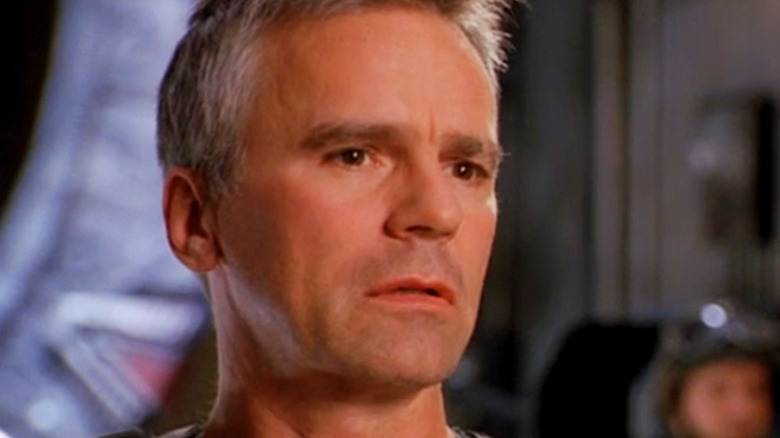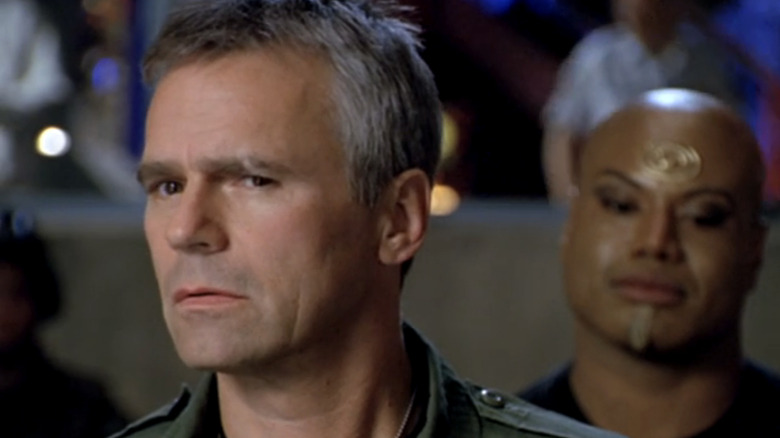It may not have as widespread and devoted a fanbase as one thing like “Star Trek” or the cultural caché of “Star Wars,” however the “Stargate” franchise is surprisingly expansive. Although it started with a single movie directed by Roland Emmerich, the saga shortly grew to include a number of TV sequence, direct-to-home-media films, comics, video video games, and books. Which for the uninitiated, should make it appear nearly unimaginable to determine the right order to observe the “Stargate” franchise.
Fortunately, the perfect “Stargate” is early “Stargate,” which is to say Emmerich’s movie and the very first TV spin-off “Stargate SG-1.” Envisioned as a sequel to the film, “SG-1” debuted on Showtime in 1997 and adopted the identical particular operations workforce from the movie as they traversed the universe by way of the titular artifact. As a substitute of Kurt Russell, who refused to return as Colonel Jack O’Neil for the present, “SG-1” solid Richard Dean Anderson within the position, which little question helped the sequence immensely seeing as the person was already a TV legend for enjoying MacGuyver within the present of the identical title.
Although Anderson would step again from being the sequence lead because the present went on, he helped solidify its standing as a cult sci-fi hit, which lasted a full 10 years earlier than its cancellation. Throughout that point, “SG-1” additionally managed to interrupt a Guinness World Report that was in the end smashed once more by none aside from the Man of Metal just some years later.
Stargate SG-1 broke a Guinness World Report
Throughout its time on the air, “Stargate SG-1” switched from Showtime to the Sci-Fi channel (now “SyFy”) for its sixth season. It additionally has a powerful legacy, spawning additional TV reveals together with the animated sequence “Stargate Infinity” and the live-action reveals “Stargate Atlantis,” “Stargate Universe,” and “Stargate Origins” — to not point out two direct-to-home-media movies. So, despite the fact that the Sci-Fi channel canceled “SG-1” after its tenth season, that is a heck of a run, contemplating the present not solely prolonged the “Stargate” mythos and spurred additional entries within the franchise, but in addition comprised a full 214 episodes throughout its 10 years on the air.
What’s extra, “SG-1” managed to interrupt the Guinness world report for the Longest Consecutive Working Sci-Fi TV Present. Fan website Gateworld reported on the feat again in 2007, noting how the present had “run and not using a break” for almost 10 years at that time. The episode that pushed “SG-1” over the sting was its 203rd, “Firm of Thieves,” which first aired September 15, 2006. At the moment the opposite longest-running sci-fi sequence, “The X-Information,” had run from September 10, 1993 to Could 9, 2002 and comprised 202 episodes.
As time went on, “The X-Information” would really prime its former rival, including extra installments to deliver its whole variety of episodes to 218. However these episodes weren’t consecutive, so “SG-1” would have held onto the report had it not been for one more long-running present…
Superman took down SG-1… type of
“Smallville” could have been a superhero story at coronary heart, but it surely certified as a sci-fi sequence to the parents over at Guinness. In Could 2011, Gateworld reported that “Smallville” was set to wrap up, having taken the report for Longest Consecutive Working Sci-Fi TV Present from “SG-1” the month prior. Like “Stargate,” the hit WB/CW sequence had run for 10 seasons, and surpassed its rival with its 215th episode. By the point “Smallville” ended it had racked up 218 installments, matching the aforementioned “X-Information.” Nonetheless, in contrast to that different seminal sci-fi sequence, the Tom Welling-led present had been produced consecutively.
As Gateworld famous on the time, the principle purpose why “Smallville” beat out “SG-1” regardless of each reveals lasting for 10 seasons was as a result of “SyFy lowered its customary episode order from 22 to twenty per 12 months, starting with the eighth season,” whereas the community that hosted “Smallville,” The CW, “continued the extra industry-standard follow of twenty-two episodes annually.” Apparently sufficient, each reveals had been produced in Vancouver, Canada, with Lois Lane actor Erica Durance making an look on “SG-1” as Teal’c’s next-door neighbor, Krista, within the season 8 episode “Affinity.”
All of which is nice, but it surely appears Guinness stirred some controversy with this specific report, as “Physician Who” followers cried out for his or her present, which in its authentic run comprised 694 episodes, to be acknowledged. The British sequence has since been handed the world report for “Most consecutive sci-fi TV episodes ever,” with Guinness noting how “Physician Who” — which returned for a brand new run of episodes in 2024 — aired “694 episodes consecutively throughout 26 seasons” between November 23, 1963 and December 6, 1989 and was “on air for 26 years 14 days.” How this did not qualify the present for the “Longest Consecutive Working Sci-Fi TV Present” report stays unclear, however no less than issues appear to have been rectified considerably within the years since “Smallville” claimed the win.


